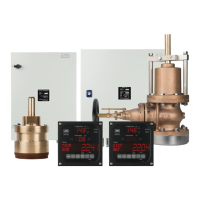11-4
2 Hardware
The IEC 61162-1/NMEA and IEC 61162-2/NMEA standard specifies serial data links with
one talker and multiple listeners, using for each talker a separate signal pair with all listeners
opto-isolated.
Both standards, IEC 61162-1 and IEC 61162-2, use the same serial data message definition
but the hardware has some differences on the receiving side. IEC 61162-2 uses a more
complex receiver stage as it is designed for a higher speed, 38400 b/s (bit per second)
compared to 4800 b/s used in IEC 61162-1.
The serial data drivers are designed with driver circuits complying with IEC 61162-1 and IEC
61162-2 standard using differential outputs swinging in the range 0 to +5 Volts. The polarities
of the signals are defined by "A" and "B". In the idling state the "A" terminal carries 0 Volt
and the "B" terminal +5 Volts. Maximum load on each driver circuits is 100 ohm which is
equal to ten IEC 61162-1/NMEA inputs in parallel.
The IEC 61162-1/NMEA inputs use opto-couplers to assure isolation between the talker and
the listener according to the IEC standard.
The IEC 61162-2/NMEA inputs uses opto-isolated RS485 receivers with a DC power supply
which is isolated from case ground as well as from the DC power in the receiving unit.
We do not recommend any other technical solution, than those mentioned above, for
connecting equipment to NMEA networks were our products are connected as talkers or
listeners. Some early proposals for the IEC 1162-1 permitted also the use of RS422 receivers,
having a DC path between case ground and the receiver circuit. We strongly discourage such
use and recommend the use of a separate, opto-isolated buffer unit if it is necessary to feed
such devices.
The interface speed for IEC 61162-1/NMEA is 4800 b/s with 8 bits of data, no parity, and one
stop bit. At 4800 b/s you can only send 480 characters in one second. Since an NMEA
sentence can be as long as 82 characters you can be limited to less than 6 different sentences
per second. The actual limit is determined by the specific sentences used, but this shows that
it is easy to overrun the capacity of the interface.

